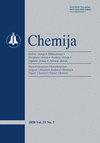Lithuanian Royal jelly: quality assessment, biological activity and quantitative determination of trans-10-hydroxy-2-decenoic acid in various solvents
IF 0.4
4区 化学
Q4 CHEMISTRY, MULTIDISCIPLINARY
引用次数: 2
Abstract
3 Department of Analytical and Toxicological Chemistry, Faculty of Pharmacy, Lithuanian University of Health Sciences, 13 Sukilėlių Avenue, 50161 Kaunas, Lithuania Royal jelly is a bee product with a high commercial interest due to its exceptional biological properties and unique composition. In this study, we evaluated the quality of Lithuanian Royal jelly, including the water content, antioxidant activity, amount of polyphenolic compounds and pH. The results indicated that Lithuanian Royal jelly had the values of pH, water content as well as polyphenols that were comparable to the data already published. In the study, we also evaluated the impact of various solvents on the amount of 10-hydroxy-2-decenoic acid (10-HDA), the main fatty acid, naturally occurring only in Royal jelly and which is the quality marker, in solutions obtaining the amount using the HPLC method. According to solubility tests performed, 10-HDA from Royal jelly is best soluble in ethanol of various concentrations, yet in order to be used for exceptional Royal jelly antibacterial and many other biological properties it was important to increase the solubility in aqueous solutions. Addition of β-cyclodextrin has increased the amount of 10-HDA in solution up to the level of ethanol solutions. The antioxidant and antibacterial tests have demonstrated that Lithuanian Royal jelly exhibits positive effects against free radicals, as well as mostly occurring bacterial strains, such as Esherichia coli, Pseudomonas aeruginosa, Enterococcus faecalis and Staphylococcus aureus. As the conclusion of this study, we can assume that the quality assessment methods chosen for this study, are significant for standardizing the procedures for further studies.立陶宛蜂王浆:反式10-羟基-2-十烯酸在不同溶剂中的质量评价、生物活性及定量测定
3立陶宛卫生科学大学药学院分析和毒理学化学系,立陶宛考纳斯苏基莱利大道13号,50161。蜂王浆是一种具有特殊生物特性和独特成分的蜂产品,具有很高的商业价值。在本研究中,我们对立陶宛蜂王浆的质量进行了评估,包括含水量、抗氧化活性、多酚化合物的含量和pH值。结果表明,立陶宛蜂王浆具有与已公布数据相当的pH值、含水量和多酚值。在这项研究中,我们还评估了各种溶剂对10-羟基-2-癸烯酸(10-HDA)含量的影响,10-HDA是主要的脂肪酸,仅天然存在于蜂王浆中,是质量标志,在使用HPLC方法获得该含量的溶液中。根据进行的溶解度测试,蜂王浆中的10-HDA在不同浓度的乙醇中最易溶解,但为了用于蜂王浆的特殊抗菌和许多其他生物特性,增加在水溶液中的溶解度是很重要的。β-环糊精的加入使溶液中10-HDA的含量增加到乙醇溶液的水平。抗氧化和抗菌测试表明,立陶宛蜂王浆对自由基以及大多数常见的细菌菌株具有积极作用,如大肠杆菌、铜绿假单胞菌、粪肠球菌和金黄色葡萄球菌。作为本研究的结论,我们可以假设为本研究选择的质量评估方法对规范进一步研究的程序具有重要意义。
本文章由计算机程序翻译,如有差异,请以英文原文为准。
求助全文
约1分钟内获得全文
求助全文
来源期刊

Chemija
化学-化学综合
CiteScore
1.30
自引率
16.70%
发文量
14
审稿时长
>12 weeks
期刊介绍:
Chemija publishes original research articles and reviews from all branches of modern chemistry, including physical, inorganic, analytical, organic, polymer chemistry, electrochemistry, and multidisciplinary approaches.
 求助内容:
求助内容: 应助结果提醒方式:
应助结果提醒方式:


